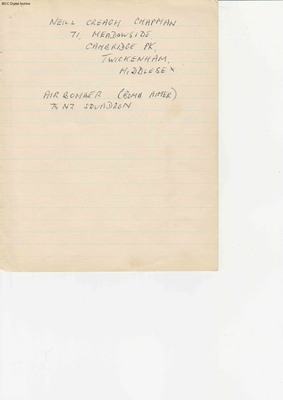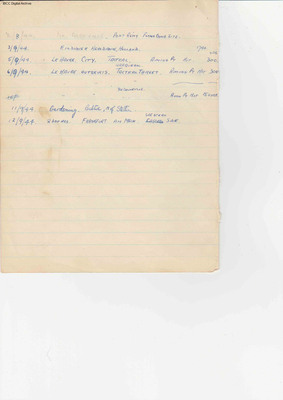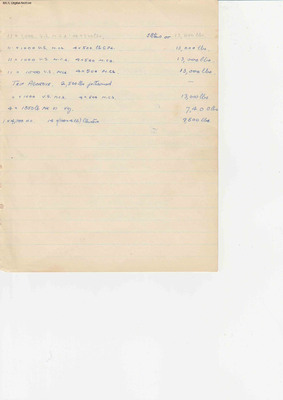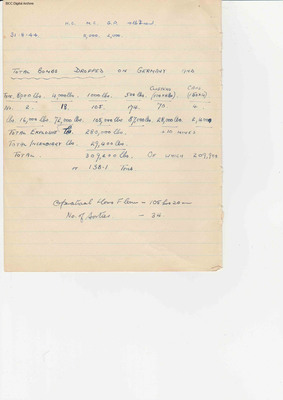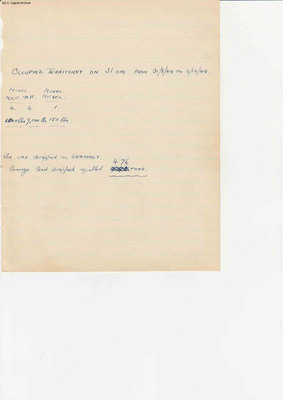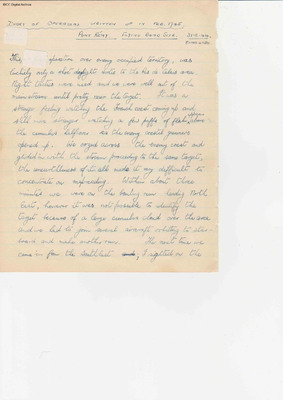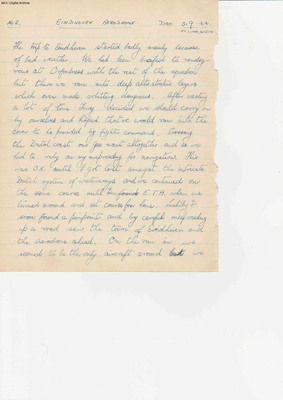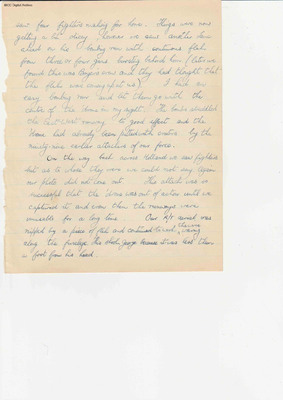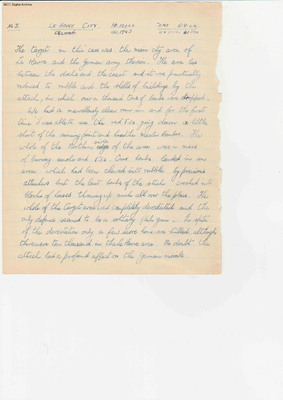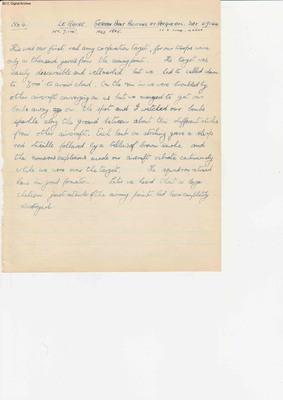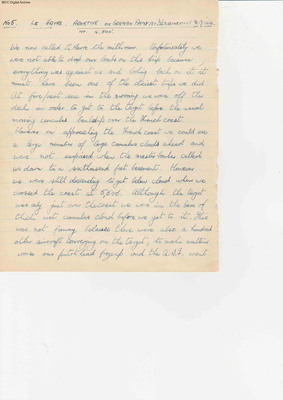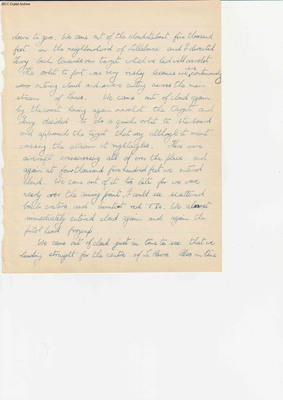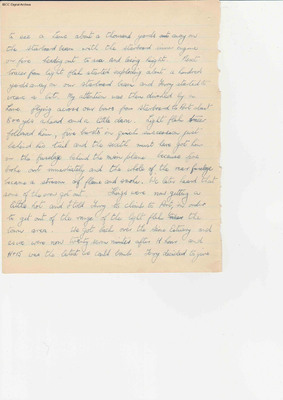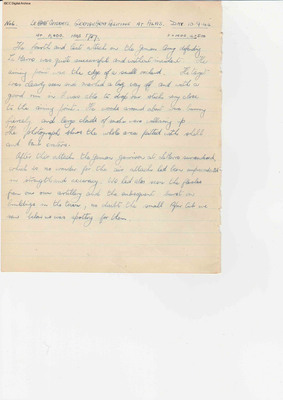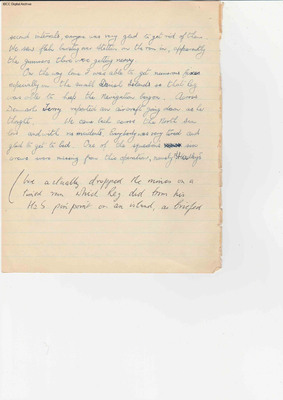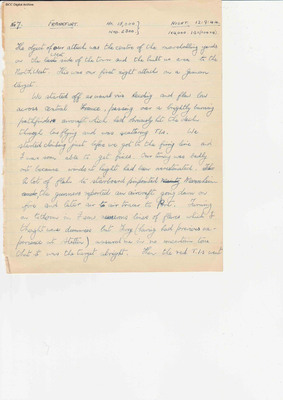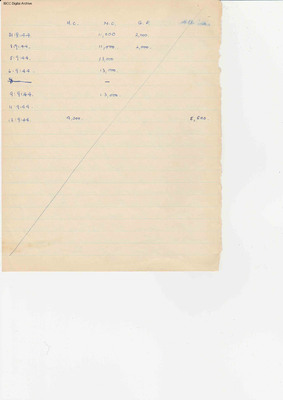Diary of Operations Written Up in February 1945
Title
Diary of Operations Written Up in February 1945
Description
Description of bombing and mine laying operations on targets around Le Havre, Calais, Stettin, Eindhoven, Frankfurt and Pont Rémy during September 1944.
Creator
Date
1945-02
Temporal Coverage
Spatial Coverage
Language
Format
24 handwritten sheets
Publisher
Rights
This content is available under a CC BY-NC 4.0 International license (Creative Commons Attribution-NonCommercial 4.0). It has been published ‘as is’ and may contain inaccuracies or culturally inappropriate references that do not necessarily reflect the official policy or position of the University of Lincoln or the International Bomber Command Centre. For more information, visit https://creativecommons.org/licenses/by-nc/4.0/ and https://ibccdigitalarchive.lincoln.ac.uk/omeka/legal.
Contributor
Identifier
YChapmanN153939v20001,
YChapmanN153939v20002,
YChapmanN153939v20003,
YChapmanN153939v20004,
YChapmanN153939v20005,
YChapmanN153939v20006,
YChapmanN153939v20007,
YChapmanN153939v20008,
YChapmanN153939v20009,
YChapmanN153939v20010,
YChapmanN153939v20011,
YChapmanN153939v20012,
YChapmanN153939v20013,
YChapmanN153939v20014,
YChapmanN153939v20015,
YChapmanN153939v20016,
YChapmanN153939v20017,
YChapmanN153939v20018,
YChapmanN153939v20019,
YChapmanN153939v20020,
YChapmanN153939v20021,
YChapmanN153939v20022,
YChapmanN153939v20023,
YChapmanN153939v20024
YChapmanN153939v20002,
YChapmanN153939v20003,
YChapmanN153939v20004,
YChapmanN153939v20005,
YChapmanN153939v20006,
YChapmanN153939v20007,
YChapmanN153939v20008,
YChapmanN153939v20009,
YChapmanN153939v20010,
YChapmanN153939v20011,
YChapmanN153939v20012,
YChapmanN153939v20013,
YChapmanN153939v20014,
YChapmanN153939v20015,
YChapmanN153939v20016,
YChapmanN153939v20017,
YChapmanN153939v20018,
YChapmanN153939v20019,
YChapmanN153939v20020,
YChapmanN153939v20021,
YChapmanN153939v20022,
YChapmanN153939v20023,
YChapmanN153939v20024
Transcription
Neill Creagh Chapman
71, Meadowside
Cambridge Pk,
Twickenham
Middlesex
Air Bomber (Bomb Aimer)
75 NZ Squadron
[list] 31/8/44. NR. ABBEVILLE, PONT RÉMY FLYING BOMB SITE. 3/9/44. EINDHOVEN AERODROME, HOLLAND. 1740. 5/9/44. LE HAVRE. CITY. TACTICAL. AIMING PT HIT. 300. YDS. 6/9/44. LE HARVE OUTSKIRTS. HARQUEBOC. TACTICAL TARGET. AIMING PT HIT. 300. “ “ “ “ “ “ “ “. [deleted] 12/ [/deleted] “ “ DEDOUNEVILLE. AIMIN PT HIT 150 YDS.11/9/44. Gardening. Baltic, N of Stettin. 12/9/44. 2300HRS. FRANKFURT AM MAIN. [deleted] EASTERN [/deleted] [inserted] WESTERN [/inserted] SIDE.
[page break]
[list] 11 x 1,000. U.S. M.Cs. (Medium Capacity) 4 x 500lbs, 5.8 tons or 13,000lbs. 11 x 1000 U.S. M.Cs. 4 x 500. lb G.Ps. (General Purpose) 13,000lbs. 11 x 1000 U.S. M.Cs. 4 x 500 M.Cs 13,000lbs. 11 x 1000 U.S. MCs 4 x 500 M.Cs. 13,000lbs. TRIP ABORTIVE. 2,5000lbs jettisoned. [sic] 11 x 1000 U.S. M.C.S. 4 x 500 M.Cs. 13,000lbs. 4 x 1850lb MK VI Veg. 7,400lbs. 1 x 4,000 H.C. 14 x (100 x 4lb) Clusters 9,600lbs.
[page break]
H.C. M.C. G.P. 4lb Incend.
31:8:44. 11,000. 2,000.
[underlined] TOTAL BOMBS DROPPED [/underlined] ON GERMANY AND
[list] [underlined] TYPE. [/underlined] [underlined] 8,000lbs. [/underlined] [underlined] 4,000lbs. [/underlined] [underlined] 1000lbs. [/underlined] [underlined] 500lbs. [/underlined] [underlined] CLUSTERS (100 x 4lbs). [/underlined] [underlined] CANS. (150 x 4). [/underlined] No. 2. 18. 105. 174. 70. 4. Lbs [underlined] 16,000lbs. [/underlined] [underlined] 72,000lbs. [/underlined] [underlined] 105,000lbs. [/underlined] [underlined] 87,000lbs. [/underlined] [underlined] 28,000lbs. [/underlined] [underlined] 2,400 [/underlined]
TOTAL EXPLOSIVE lbs. 280,000lbs. + 10 MINES
TOTAL INCENDIARY lbs. [underlined] 29,400lbs. [/underlined]
TOTAL. 309,400lbs. OF WHICH 209,900 or 138.1 Tons.
Operational Hours Flown – 105 hrs 20 mins. No. of Sorties. – 34.
[page break]
OCCUPIED TERRITORRY [sic] ON 31 OPS FROM 31/8/44 TO 6/12/44.
[underlined] MINES. MK. IV. [/underlined] 4. [underlined] MK VI. [/underlined] 6. [underlined] MUNRO. NICKEL. [/underlined] 1. [underlined] 6000lbs. [/underlined] [underlined] 9,000lbs. [/underlined] [underlined] 150lbs. [/underlined]
Lbs was dropped on GERMANY. Average load dropped equalled [underlined] 4.76 TONS. [/underlined]
[page break]
[underlined] DIARY OF OPERATIONS WRITTEN UP IN FEB. 1945. [/underlined]
[underlined] PONT RÉMY. FLYING BOMB SITE. 31:8:44. [/underlined] 8 x 1000. 4 x 500.
This, operation over enemy occupied territory, was luckily only a short daylight sortie to the Pas de Calais area. Night tactics were used and we were well out of the main stream until pretty near the target. It was a strange feeling watching the French coast coming up and still more stranger watching a few puffs of flak [inserted] appear [/inserted] above the cumulus half cover as the enemy coastal gunners opened up. We oozed across the enemy coast and glided in with the stream proceeding to the same target, the unearthliness of it all made it very difficult to concentrate on map reading. Within about three minutes we were on the bombing run heading North East, however it was not possible to identify the target because of a large cumulus cloud over the area and we had to join several aircraft orbitting [sic] to starboard and make another run. The next time we came in from the South East [deleted] and [/deleted], I sighted on the
[page break]
corner of a wood which looked like the target and let the bombs go. The result was good for the bombs burst on the aiming point, half of them straddling a main road alongside the target and sending up spurts of brown dirt. On the way back we passed bang over Abbeville and were lucky that nothing opened up at us, neither was there any flak over the target. This was one of our eariest [sic] trips but not a very successful one. Unfortunately our photo failed to come out because of condensation.
[page break
[underlined] No 2. EINDHOVEN AERODROME. [/underlined] DAY. [underlined] 3:9:44. [/underlined] 11 x 1,000, 4 x 500
The trip to Eindhoven started badly mainly because of bad weather. We had been breifed [sic] to rendezvous at Orfordness with the rest of the squadron but there we ran into deep alto stratus layers which even mad orbitting [sic] dangerous. After wasting a lot of time Terry decided we should carry on by ourselves and hoped that we would run into the cover to be provided by fighter command. Crossing the Dutch coast our Gee went altogether and so we had to rely on my map reading for navigation. This was O.K. until I got lost amongst the intricate Dutch system of waterways and we continued on the same course until [deleted] I found [/deleted] E.T.A. when we turned around and set course for home. Luckily I soon found a pinpoint and by careful map reading up a road saw the town of Eindhoven and the aerodrome ahead. On the run in we seemed to be the only aircraft around but we
[page break]
saw four fighters making for home. Things were now getting a bit dicey, however we saw another Lanc ahead on his bombing run with continuous flak from three or four guns bursting behind him (later we found this was Boyer’s crew and they had thought that the flak was coming up at us). I had an eary [sic] bombing run and let them go with the centre of the ‘drome in my sight. The bombs straddled the East-West runway to good effect and the ‘drome had already been pitted with craters by the ninety-nine earlier attackers of our force.
On the way back across Holland we saw fighters but as to whose they were we could not say. Again our photo did not come out. This attack was so successful that the ‘drome was out of action until we captured it and even then the runways were unusable for a long time. Our R/T aerial was nipped by a piece of flak and continued to work [inserted] the wire [/inserted] waving along the fuselage. This shook George because it was less than a foot from his head.
[page break]
[underlined] No 3. [/underlined] [underlined] LE HAVRE CITY. [/underlined] Ht. 12.000. HRS. 1943 [underlined] DAY 5:9:44. [/underlined] 11 x 1000. 4 x 500
The target in this case was the main city area of Le Havre and the German army therein. The area lies between the docks and the coast and it was practically reduced to rubble and the shells of buildings by the attack, in which over a thousand tons of bombs were dropped.
We had a marvellously clear run in and for the first time I was able to see the red T.Is going down a little short of the aiming point and hear the Master Bomber. The whole of the Northern [deleted] edge [/deleted] [inserted] side [/inserted] of the area was a mass of burning smoke and T.Is. Our bombs landed in an area which had been chewed into rubble by previous attackers but the last bombs of the stick crashed into blocks of houses throwing up muck all over the place. The whole of the target area was completely devastated and the only defence seemed to be a solitary flak gun. In spite of the devastation only a few score huns were killed, although there were ten thousand in the Le Havre area. No doubt the attack had a profound affect [sic] on the German morale.
[page break]
[underlined] No 4. [/underlined] [underlined] LE HAVRE. [/underlined] HT. 7,000’. [underlined] GERMAN ARMY POSITIONS AT HARQUEBOC. [/underlined] HRS 1802. [underlined] DAY 6:9:44. [/underlined] 11 x 1000. 4 x 500.
This was our first real army co-operation target, for our troops were only a thousand yards from the aiming point. The target was easily descernible [sic] and well marked but we had to called down to 7,000’ to avoid cloud. On the run in we were troubled by other aircraft converging on us but we managed to get our bombs away [deleted] ag [/deleted] on the spot and I watched our bombs sparkle along the ground between about ten different sticks from other aircraft. Each bomb on striking gave a sharp red twinkle followed by a billow of brown smoke and the numerous explosions made our aircraft vibrate continuously while we were over the target. The squadron returned home in good formation. Later we heard that a large chateau just outside of the aiming point had been completely destroyed.
[page break]
[underlined] No 5. [/underlined] [underlined] LE HAVRE. [/underlined] [underlined] ABORTIVE ON GERMAN ARMY AT DÉDOUNEVILLE. [/underlined] Ht. 4,500’. [underlined] 8:9:44. [/underlined]
We now called Le Havre the milk run. Unfortuneately [sic] we were not able to drop our bombs on this trip because everything was against us and looking back on it it must have been one of the diciest trips we did. At five past six in the morning we were off the deck in order to get to the target before the usual morning cumulus banked up over the French coast.
However on approaching the French coast we could see a large number of large cumulus clouds ahead and were not surprised when the master bomber called us down to a six thousand feet basement. However we were still descending to get below cloud when we crossed the coast at 5,500’. Although the target was only just over the coast we were in the base of thick wet cumulus cloud before we got to it. This was not funny because there were also a hundred other aircraft converging on the target, to make matters worse our pitot head froze up and the A.S.I. went
[page break]
down to zero. We came out of the cloud at about five thousand feet in the neighbourhood of Lillebonne and I directed Terry back towards our target which we had well overshot.
The orbit to port was very risky because we [inserted] were [/inserted] continuously [deleted] were [/deleted] entering cloud and we were cutting across the main stream of Lanc. We came out of cloud again by the coast having again overshot the target and Terry decided to do a quick orbit to starboard and approach the target that way although it meant crossing the stream at rightangles. There were aircraft crisscrossing all over the place and again at four thousand five hundred feet we entered cloud. We came out of it too late for we were nearly over the aiming point, I could see scattered bomb craters and burntout red T.Is. We almost immediately entered cloud again and again the pitot head froze up.
We came out of cloud just in time to see that we heading straight for the centre of Le Havre. Also in time
[page break]
to see a Lanc about a thousand yards [deleted] out [/deleted] away on the Starboard beam with the Starboard inner engine on fire heading out to sea and losing height. Next tracer from light flak started exploding about a hundred yards away on our starboard beam and Terry started to weave a bit. My attention was then diverted by a Lanc. flying across our bows from Starboard to Port about 800 yds ahead and a little down. Light flak tracer followed him, five bursts in quick succession just behind his tail and the sixth must have got him in the fuselage behind the main plane because fire broke out immediately and the whole of the rear fuselage became a stream of flame and smoke. We later heard that some of the crew got out. Things were now getting a little hot and I told Terry to climb to Port, in order to get out of the range of the light flak [deleted] near [/deleted] [inserted] in [/inserted] the town area. We got back over the Seine Estuary and as we were now twenty seven minutes after H hour and H+15 was the latest we could bomb Terry decided to give
[page break]
it up, which was perhaps just as well. Very few fellows managed to drop their bombs because of the sticky weather and altogether the flak gunners knocked down four or five of our aircraft.
Back over the channel the weather was clear and cheerful, the Mulberry docks at Arromanches clearly visible. We also saw a large battleship which had apparently taken part in a naval bombardment.
In fact the attack was cancelled by the “Long Stop” controller.
Both Master Bombers had been shot down & since there was no-one left to control the bombing & Canadian troops were right on the edge of the bombing area it was considered to [sic] dangerous to them to continue.
[page break]
[underlined] No 6. LE HAVRE OUTSKIRTS. GERMAN ARMY POSITIONS AT ALVIS. DAY. 10:9:44. HT. 11,000. HRS 1737. 11 X 1000. 4 X 500 [/underlined]
The fourth and last attack on the German Army defending Le Havre was quite successful and without incident. The aiming point was the edge of a small orchard. The target was clearly seen and marked a long way off and with a good run in I was able to drop our stick very close to the aiming point. The woods around about were burning fiercely and large clouds of smoke were wallowing up. The photograph shows the whole area pitted with shell and bomb craters.
After this attack the German garrison at Le Havre surrendered which is no wonder for the air attack had been unprecedented in strength and accuracy. We had also seen the flashes from our own artillery and the subsequent burst on buildings in the town, no doubt the small Piper Cub we saw below us was spotting for them.
[page break]
[underlined] No 7. BALTIC. 14 25’E. 54 20’N. NIGHT. 11:9:44. 4 x MK IV MINES. [/underlined]
This was the longest operation we did and was also the first night operation we had to do. Our objective was to drop mines off the coast of Germany just North of Stettin Bay. Our route was by way of central Denmark and then turning South in to the Baltic, and our track back was the reverse of that there.
We started off in the half light of the evening and flew low over the North Sea. [deleted] and [/deleted] Soon aircraft were visible all around us and one kept in our vicinity for about an hour, this we guessed was John winter and crew. Crossing Denmark at six thousand feet we saw quite a few fighter flares around especially ahead of us. I was busy taking fixes the whole time and we got on to the run in bang on track. I got down in the nose while Reg lined us up with a coastal pinpoint. An aircraft flashed past us headon, I expect on his way home from his dropping area, only missing us by feet. On Reg’s word I released the mines one at a time at five
[page break]
second intervals, everyone was very glad to get rid of them. We saw flak bursting over Stettin on the run in, apparently the gunners there were getting nervy.
On the way home I was able to get numerous fixes especially on the small Danish Islands so that Reg was able to keep the navigation bang on. Across Denmark Terry reported an aircraft going down as he thought. We came back across the North Sea low and with no incidents. Everybody was very tired and glad to get to bed. One of the squadron’s six crews were missing from this operation, namely F/S Hadley’s
We actually dropped the mines on a timed run which Reg did from his H2S pinpoint on an island, as briefed
[page break]
[underlined] No 7. FRANKFURT [/underlined] Ht. 18,000. HRS. 2300. [underlined] NIGHT. 12:9:44. [/underlined] 1 x 4,000 14 x (100 x 4).
The object of our attack was the centre of the marshalling yards on the [deleted] East [/deleted] [inserted] West [/inserted] side of the town and the built up area to the North West. This was our first night attack on a German target.
We started off as usual via Reading and flew low across central France, passing over a brightly burning pathfinder aircraft which had obviously hit the deck through low flying and was scattering T.Is. We started climbing just before we got to the firing line and I was soon able to get fixes. Our timing was badly out because winds at height had been overestimated. [deleted] Th [/deleted] A lot of flak to Starboard pinpointed [deleted] Maintz [/deleted] Mannheim [deleted] and [/deleted, the gunners reported an aircraft going down on fire and later air to air tracer to Port. Turning on to the run in I saw numerous lines of flares which I thought were dummies but Terry (having had previous experience at Stettin) assured me in no uncertain tone that it was the target alright. Then the red T.Is went
[page break]
[list headings] [space] H.C. M.C. G.P. 4LB inc’s.
[list] 31:8:44. [space] 11,000. 2,000. [space] 3:9:44. [space] 11,000. 2,000. [space] 5:9:44. [space] 13,000. [space] [space] 6:9:44. [space] 13,000. [space] [space] – [space] – [space] [space] 9:9:44. [space] 13,000. [space] [space] 11:9:44. [space] [space] [space] [space] 12:9:44. 4,000. [space] 5,600.
[page break]
[list headings] MINES. TOTAL.
[list] [space] 13,000. [space] 13,000. [space] 13,000. [space] 13,000. [space] [space] [space] 13,000. 7,400. 7,400. [space] 9,600
[page break]
down and the sky became filled with searchlights especially along the river towards Wiesbaden. Flak was bursting above and below but not very thickly. On the ground the colour gradually increased till several areas of red T.Is were surrounded with lines of yellow incendiary fires and the red centred glow of cookies exploding. I aimed at the centre of the T.Is and let our bombs go, passing over the city I was able to see the riverside town with its bridges from the light of our explosions. We took our photo and turned for home. The target was now a beautiful sight, the fire and smoke was terrific, the glow lit of [sic] the sky for miles around and we seemed a perfect target for night fighters. To our Port a long row of massed searchlights waved wildly, however we were soon across the Rhine and losing height for home.
[page break]
[underlined] No.8. & No 10. CALAIS. (ABORTIVE). [/underlined] DAY [underlined] 25:9:44 & 28:9:44. [/underlined]
These two operations may be classified together for although not in sequence they were both abortive due to that harassing enemy of the continent, namely cumulus cloud. The targets were both in aid of the army, in the first case being an artillery battery. This raid would have been a cinch had in [sic] been that on the run-in we were about a minute too late. The Pathfinder had been in and finding thick cloud over the target had ordered us to orbit, this we did until he had managed to get in and drop a T.I. We then went in but were disappointed to find gap had closed up. I could a smoke trail were a T.I. must have gone down but as our troops were so close I could not risk bombing it. We then got the order to abandon the op. and so we returned home with our bombs after jettisonning [sic] a couple of them in the Channel.
The second raid was even worse for we just orbitted [sic] over the channel and the target until the Master Bomber told us to abandon the mission.
[page break]
[underlined] No 9. CALAIS. [/underlined] HRS. [underlined] GERMAN ARMY DEFENCES. DAY. 28:9:44. [/underlined] 11 x 1000. 4 x 500.
This attack took place between the two abortives already mentioned and was much more successful
End of transcription
71, Meadowside
Cambridge Pk,
Twickenham
Middlesex
Air Bomber (Bomb Aimer)
75 NZ Squadron
[list] 31/8/44. NR. ABBEVILLE, PONT RÉMY FLYING BOMB SITE. 3/9/44. EINDHOVEN AERODROME, HOLLAND. 1740. 5/9/44. LE HAVRE. CITY. TACTICAL. AIMING PT HIT. 300. YDS. 6/9/44. LE HARVE OUTSKIRTS. HARQUEBOC. TACTICAL TARGET. AIMING PT HIT. 300. “ “ “ “ “ “ “ “. [deleted] 12/ [/deleted] “ “ DEDOUNEVILLE. AIMIN PT HIT 150 YDS.11/9/44. Gardening. Baltic, N of Stettin. 12/9/44. 2300HRS. FRANKFURT AM MAIN. [deleted] EASTERN [/deleted] [inserted] WESTERN [/inserted] SIDE.
[page break]
[list] 11 x 1,000. U.S. M.Cs. (Medium Capacity) 4 x 500lbs, 5.8 tons or 13,000lbs. 11 x 1000 U.S. M.Cs. 4 x 500. lb G.Ps. (General Purpose) 13,000lbs. 11 x 1000 U.S. M.Cs. 4 x 500 M.Cs 13,000lbs. 11 x 1000 U.S. MCs 4 x 500 M.Cs. 13,000lbs. TRIP ABORTIVE. 2,5000lbs jettisoned. [sic] 11 x 1000 U.S. M.C.S. 4 x 500 M.Cs. 13,000lbs. 4 x 1850lb MK VI Veg. 7,400lbs. 1 x 4,000 H.C. 14 x (100 x 4lb) Clusters 9,600lbs.
[page break]
H.C. M.C. G.P. 4lb Incend.
31:8:44. 11,000. 2,000.
[underlined] TOTAL BOMBS DROPPED [/underlined] ON GERMANY AND
[list] [underlined] TYPE. [/underlined] [underlined] 8,000lbs. [/underlined] [underlined] 4,000lbs. [/underlined] [underlined] 1000lbs. [/underlined] [underlined] 500lbs. [/underlined] [underlined] CLUSTERS (100 x 4lbs). [/underlined] [underlined] CANS. (150 x 4). [/underlined] No. 2. 18. 105. 174. 70. 4. Lbs [underlined] 16,000lbs. [/underlined] [underlined] 72,000lbs. [/underlined] [underlined] 105,000lbs. [/underlined] [underlined] 87,000lbs. [/underlined] [underlined] 28,000lbs. [/underlined] [underlined] 2,400 [/underlined]
TOTAL EXPLOSIVE lbs. 280,000lbs. + 10 MINES
TOTAL INCENDIARY lbs. [underlined] 29,400lbs. [/underlined]
TOTAL. 309,400lbs. OF WHICH 209,900 or 138.1 Tons.
Operational Hours Flown – 105 hrs 20 mins. No. of Sorties. – 34.
[page break]
OCCUPIED TERRITORRY [sic] ON 31 OPS FROM 31/8/44 TO 6/12/44.
[underlined] MINES. MK. IV. [/underlined] 4. [underlined] MK VI. [/underlined] 6. [underlined] MUNRO. NICKEL. [/underlined] 1. [underlined] 6000lbs. [/underlined] [underlined] 9,000lbs. [/underlined] [underlined] 150lbs. [/underlined]
Lbs was dropped on GERMANY. Average load dropped equalled [underlined] 4.76 TONS. [/underlined]
[page break]
[underlined] DIARY OF OPERATIONS WRITTEN UP IN FEB. 1945. [/underlined]
[underlined] PONT RÉMY. FLYING BOMB SITE. 31:8:44. [/underlined] 8 x 1000. 4 x 500.
This, operation over enemy occupied territory, was luckily only a short daylight sortie to the Pas de Calais area. Night tactics were used and we were well out of the main stream until pretty near the target. It was a strange feeling watching the French coast coming up and still more stranger watching a few puffs of flak [inserted] appear [/inserted] above the cumulus half cover as the enemy coastal gunners opened up. We oozed across the enemy coast and glided in with the stream proceeding to the same target, the unearthliness of it all made it very difficult to concentrate on map reading. Within about three minutes we were on the bombing run heading North East, however it was not possible to identify the target because of a large cumulus cloud over the area and we had to join several aircraft orbitting [sic] to starboard and make another run. The next time we came in from the South East [deleted] and [/deleted], I sighted on the
[page break]
corner of a wood which looked like the target and let the bombs go. The result was good for the bombs burst on the aiming point, half of them straddling a main road alongside the target and sending up spurts of brown dirt. On the way back we passed bang over Abbeville and were lucky that nothing opened up at us, neither was there any flak over the target. This was one of our eariest [sic] trips but not a very successful one. Unfortunately our photo failed to come out because of condensation.
[page break
[underlined] No 2. EINDHOVEN AERODROME. [/underlined] DAY. [underlined] 3:9:44. [/underlined] 11 x 1,000, 4 x 500
The trip to Eindhoven started badly mainly because of bad weather. We had been breifed [sic] to rendezvous at Orfordness with the rest of the squadron but there we ran into deep alto stratus layers which even mad orbitting [sic] dangerous. After wasting a lot of time Terry decided we should carry on by ourselves and hoped that we would run into the cover to be provided by fighter command. Crossing the Dutch coast our Gee went altogether and so we had to rely on my map reading for navigation. This was O.K. until I got lost amongst the intricate Dutch system of waterways and we continued on the same course until [deleted] I found [/deleted] E.T.A. when we turned around and set course for home. Luckily I soon found a pinpoint and by careful map reading up a road saw the town of Eindhoven and the aerodrome ahead. On the run in we seemed to be the only aircraft around but we
[page break]
saw four fighters making for home. Things were now getting a bit dicey, however we saw another Lanc ahead on his bombing run with continuous flak from three or four guns bursting behind him (later we found this was Boyer’s crew and they had thought that the flak was coming up at us). I had an eary [sic] bombing run and let them go with the centre of the ‘drome in my sight. The bombs straddled the East-West runway to good effect and the ‘drome had already been pitted with craters by the ninety-nine earlier attackers of our force.
On the way back across Holland we saw fighters but as to whose they were we could not say. Again our photo did not come out. This attack was so successful that the ‘drome was out of action until we captured it and even then the runways were unusable for a long time. Our R/T aerial was nipped by a piece of flak and continued to work [inserted] the wire [/inserted] waving along the fuselage. This shook George because it was less than a foot from his head.
[page break]
[underlined] No 3. [/underlined] [underlined] LE HAVRE CITY. [/underlined] Ht. 12.000. HRS. 1943 [underlined] DAY 5:9:44. [/underlined] 11 x 1000. 4 x 500
The target in this case was the main city area of Le Havre and the German army therein. The area lies between the docks and the coast and it was practically reduced to rubble and the shells of buildings by the attack, in which over a thousand tons of bombs were dropped.
We had a marvellously clear run in and for the first time I was able to see the red T.Is going down a little short of the aiming point and hear the Master Bomber. The whole of the Northern [deleted] edge [/deleted] [inserted] side [/inserted] of the area was a mass of burning smoke and T.Is. Our bombs landed in an area which had been chewed into rubble by previous attackers but the last bombs of the stick crashed into blocks of houses throwing up muck all over the place. The whole of the target area was completely devastated and the only defence seemed to be a solitary flak gun. In spite of the devastation only a few score huns were killed, although there were ten thousand in the Le Havre area. No doubt the attack had a profound affect [sic] on the German morale.
[page break]
[underlined] No 4. [/underlined] [underlined] LE HAVRE. [/underlined] HT. 7,000’. [underlined] GERMAN ARMY POSITIONS AT HARQUEBOC. [/underlined] HRS 1802. [underlined] DAY 6:9:44. [/underlined] 11 x 1000. 4 x 500.
This was our first real army co-operation target, for our troops were only a thousand yards from the aiming point. The target was easily descernible [sic] and well marked but we had to called down to 7,000’ to avoid cloud. On the run in we were troubled by other aircraft converging on us but we managed to get our bombs away [deleted] ag [/deleted] on the spot and I watched our bombs sparkle along the ground between about ten different sticks from other aircraft. Each bomb on striking gave a sharp red twinkle followed by a billow of brown smoke and the numerous explosions made our aircraft vibrate continuously while we were over the target. The squadron returned home in good formation. Later we heard that a large chateau just outside of the aiming point had been completely destroyed.
[page break]
[underlined] No 5. [/underlined] [underlined] LE HAVRE. [/underlined] [underlined] ABORTIVE ON GERMAN ARMY AT DÉDOUNEVILLE. [/underlined] Ht. 4,500’. [underlined] 8:9:44. [/underlined]
We now called Le Havre the milk run. Unfortuneately [sic] we were not able to drop our bombs on this trip because everything was against us and looking back on it it must have been one of the diciest trips we did. At five past six in the morning we were off the deck in order to get to the target before the usual morning cumulus banked up over the French coast.
However on approaching the French coast we could see a large number of large cumulus clouds ahead and were not surprised when the master bomber called us down to a six thousand feet basement. However we were still descending to get below cloud when we crossed the coast at 5,500’. Although the target was only just over the coast we were in the base of thick wet cumulus cloud before we got to it. This was not funny because there were also a hundred other aircraft converging on the target, to make matters worse our pitot head froze up and the A.S.I. went
[page break]
down to zero. We came out of the cloud at about five thousand feet in the neighbourhood of Lillebonne and I directed Terry back towards our target which we had well overshot.
The orbit to port was very risky because we [inserted] were [/inserted] continuously [deleted] were [/deleted] entering cloud and we were cutting across the main stream of Lanc. We came out of cloud again by the coast having again overshot the target and Terry decided to do a quick orbit to starboard and approach the target that way although it meant crossing the stream at rightangles. There were aircraft crisscrossing all over the place and again at four thousand five hundred feet we entered cloud. We came out of it too late for we were nearly over the aiming point, I could see scattered bomb craters and burntout red T.Is. We almost immediately entered cloud again and again the pitot head froze up.
We came out of cloud just in time to see that we heading straight for the centre of Le Havre. Also in time
[page break]
to see a Lanc about a thousand yards [deleted] out [/deleted] away on the Starboard beam with the Starboard inner engine on fire heading out to sea and losing height. Next tracer from light flak started exploding about a hundred yards away on our starboard beam and Terry started to weave a bit. My attention was then diverted by a Lanc. flying across our bows from Starboard to Port about 800 yds ahead and a little down. Light flak tracer followed him, five bursts in quick succession just behind his tail and the sixth must have got him in the fuselage behind the main plane because fire broke out immediately and the whole of the rear fuselage became a stream of flame and smoke. We later heard that some of the crew got out. Things were now getting a little hot and I told Terry to climb to Port, in order to get out of the range of the light flak [deleted] near [/deleted] [inserted] in [/inserted] the town area. We got back over the Seine Estuary and as we were now twenty seven minutes after H hour and H+15 was the latest we could bomb Terry decided to give
[page break]
it up, which was perhaps just as well. Very few fellows managed to drop their bombs because of the sticky weather and altogether the flak gunners knocked down four or five of our aircraft.
Back over the channel the weather was clear and cheerful, the Mulberry docks at Arromanches clearly visible. We also saw a large battleship which had apparently taken part in a naval bombardment.
In fact the attack was cancelled by the “Long Stop” controller.
Both Master Bombers had been shot down & since there was no-one left to control the bombing & Canadian troops were right on the edge of the bombing area it was considered to [sic] dangerous to them to continue.
[page break]
[underlined] No 6. LE HAVRE OUTSKIRTS. GERMAN ARMY POSITIONS AT ALVIS. DAY. 10:9:44. HT. 11,000. HRS 1737. 11 X 1000. 4 X 500 [/underlined]
The fourth and last attack on the German Army defending Le Havre was quite successful and without incident. The aiming point was the edge of a small orchard. The target was clearly seen and marked a long way off and with a good run in I was able to drop our stick very close to the aiming point. The woods around about were burning fiercely and large clouds of smoke were wallowing up. The photograph shows the whole area pitted with shell and bomb craters.
After this attack the German garrison at Le Havre surrendered which is no wonder for the air attack had been unprecedented in strength and accuracy. We had also seen the flashes from our own artillery and the subsequent burst on buildings in the town, no doubt the small Piper Cub we saw below us was spotting for them.
[page break]
[underlined] No 7. BALTIC. 14 25’E. 54 20’N. NIGHT. 11:9:44. 4 x MK IV MINES. [/underlined]
This was the longest operation we did and was also the first night operation we had to do. Our objective was to drop mines off the coast of Germany just North of Stettin Bay. Our route was by way of central Denmark and then turning South in to the Baltic, and our track back was the reverse of that there.
We started off in the half light of the evening and flew low over the North Sea. [deleted] and [/deleted] Soon aircraft were visible all around us and one kept in our vicinity for about an hour, this we guessed was John winter and crew. Crossing Denmark at six thousand feet we saw quite a few fighter flares around especially ahead of us. I was busy taking fixes the whole time and we got on to the run in bang on track. I got down in the nose while Reg lined us up with a coastal pinpoint. An aircraft flashed past us headon, I expect on his way home from his dropping area, only missing us by feet. On Reg’s word I released the mines one at a time at five
[page break]
second intervals, everyone was very glad to get rid of them. We saw flak bursting over Stettin on the run in, apparently the gunners there were getting nervy.
On the way home I was able to get numerous fixes especially on the small Danish Islands so that Reg was able to keep the navigation bang on. Across Denmark Terry reported an aircraft going down as he thought. We came back across the North Sea low and with no incidents. Everybody was very tired and glad to get to bed. One of the squadron’s six crews were missing from this operation, namely F/S Hadley’s
We actually dropped the mines on a timed run which Reg did from his H2S pinpoint on an island, as briefed
[page break]
[underlined] No 7. FRANKFURT [/underlined] Ht. 18,000. HRS. 2300. [underlined] NIGHT. 12:9:44. [/underlined] 1 x 4,000 14 x (100 x 4).
The object of our attack was the centre of the marshalling yards on the [deleted] East [/deleted] [inserted] West [/inserted] side of the town and the built up area to the North West. This was our first night attack on a German target.
We started off as usual via Reading and flew low across central France, passing over a brightly burning pathfinder aircraft which had obviously hit the deck through low flying and was scattering T.Is. We started climbing just before we got to the firing line and I was soon able to get fixes. Our timing was badly out because winds at height had been overestimated. [deleted] Th [/deleted] A lot of flak to Starboard pinpointed [deleted] Maintz [/deleted] Mannheim [deleted] and [/deleted, the gunners reported an aircraft going down on fire and later air to air tracer to Port. Turning on to the run in I saw numerous lines of flares which I thought were dummies but Terry (having had previous experience at Stettin) assured me in no uncertain tone that it was the target alright. Then the red T.Is went
[page break]
[list headings] [space] H.C. M.C. G.P. 4LB inc’s.
[list] 31:8:44. [space] 11,000. 2,000. [space] 3:9:44. [space] 11,000. 2,000. [space] 5:9:44. [space] 13,000. [space] [space] 6:9:44. [space] 13,000. [space] [space] – [space] – [space] [space] 9:9:44. [space] 13,000. [space] [space] 11:9:44. [space] [space] [space] [space] 12:9:44. 4,000. [space] 5,600.
[page break]
[list headings] MINES. TOTAL.
[list] [space] 13,000. [space] 13,000. [space] 13,000. [space] 13,000. [space] [space] [space] 13,000. 7,400. 7,400. [space] 9,600
[page break]
down and the sky became filled with searchlights especially along the river towards Wiesbaden. Flak was bursting above and below but not very thickly. On the ground the colour gradually increased till several areas of red T.Is were surrounded with lines of yellow incendiary fires and the red centred glow of cookies exploding. I aimed at the centre of the T.Is and let our bombs go, passing over the city I was able to see the riverside town with its bridges from the light of our explosions. We took our photo and turned for home. The target was now a beautiful sight, the fire and smoke was terrific, the glow lit of [sic] the sky for miles around and we seemed a perfect target for night fighters. To our Port a long row of massed searchlights waved wildly, however we were soon across the Rhine and losing height for home.
[page break]
[underlined] No.8. & No 10. CALAIS. (ABORTIVE). [/underlined] DAY [underlined] 25:9:44 & 28:9:44. [/underlined]
These two operations may be classified together for although not in sequence they were both abortive due to that harassing enemy of the continent, namely cumulus cloud. The targets were both in aid of the army, in the first case being an artillery battery. This raid would have been a cinch had in [sic] been that on the run-in we were about a minute too late. The Pathfinder had been in and finding thick cloud over the target had ordered us to orbit, this we did until he had managed to get in and drop a T.I. We then went in but were disappointed to find gap had closed up. I could a smoke trail were a T.I. must have gone down but as our troops were so close I could not risk bombing it. We then got the order to abandon the op. and so we returned home with our bombs after jettisonning [sic] a couple of them in the Channel.
The second raid was even worse for we just orbitted [sic] over the channel and the target until the Master Bomber told us to abandon the mission.
[page break]
[underlined] No 9. CALAIS. [/underlined] HRS. [underlined] GERMAN ARMY DEFENCES. DAY. 28:9:44. [/underlined] 11 x 1000. 4 x 500.
This attack took place between the two abortives already mentioned and was much more successful
End of transcription
Collection
Citation
Neill Chapman, “Diary of Operations Written Up in February 1945,” IBCC Digital Archive, accessed November 9, 2024, https://ibccdigitalarchive.lincoln.ac.uk/omeka/collections/document/24266.
Item Relations
This item has no relations.

